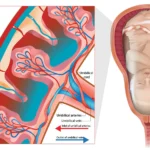Every pregnancy is different and the term “normal labour” is relative and varies from person to person. “Normal” contractions can be categorized based on what is normal to a person. Since these are unlike anything a woman has experienced, especially if it is her first pregnancy, it is good to know the difference between true and false labour pains. True labour pains can be identified from false pain by the strength and frequency of each contraction.
It is an established fact that women experience false labour pains before they have the real ones – this phenomenon is known as Braxton Hicks contractions. These infrequent contractions by the uterus are normal and are likely to start in the fourth month of a pregnancy. It is the body’s of preparing a woman for the “actual event”.
Explaining Braxton Hicks contractions
Braxton Hicks can be described as contractions or an abdominal tightening which can come and go. These are not close together and do not last long or occur often. They don’t get stronger over time and occur when there is a change in position. These can stop if the pregnant woman rests.
These false contractions usually start in the second or third trimester and doctors believe that it is the body’s way of getting ready and preparing the uterus for real labour. These pains can be a slight tightening or a spasm that can make a person breathless. In some women, these occur at a higher frequency, closer to the delivery date.

Distinguishing between False and True Labour
The time between contractions is an easy way to distinguish between true and false labour. Another indicator is the changing or stopping of contractions when you change positions, specific movement and rest. The strength of a contraction is also different, and pain occurs in different areas.
It is classified as false labor if:
- Contractions are irregular and not close together
- They go away if you walk, change position or rest
- They are not very strong and remain so, without becoming stronger or weaker
- Most of the time, the pain is in the front
It is true labor if:
- Contractions start and occur closer together, are strong and last anywhere from 30-70 seconds each
- Contractions don’t stop with rest or with movement
- They are stronger successively
- Contractions start in the back and move to the front
Here are ways to figure out if you are in true labor:
- The 5-1-1 Rule: Contractions occur at 5-minute intervals for 1 minute each and at the minimum for 1 hour
- Other signs include:
- Amniotic fluid discharge from the sac. This indicates labor is imminent and could start at any time
- The discharge of a “mucus plug” indicate a change in the cervix and labor can start any minute
- Some women may experience nausea and/or vomiting due to intense contractions and hormonal changes in the body at this time
- Some women could experience vaginal tears which makes the discomfort very intense and that delivery is imminent
- One way to know if it is true labor is to be checked by a doctor.
Call your doctor when:
-
- You leak fluid
- You notice the fetus move
- If there is blood
- If 6 or more contractions take place within an hour if you are at 37 weeks pregnant or less.
Talk to family members and the doctor as well so that your condition can be monitored during the final weeks of the pregnancy. This will help you get to the hospital on time and have a smooth delivery.






